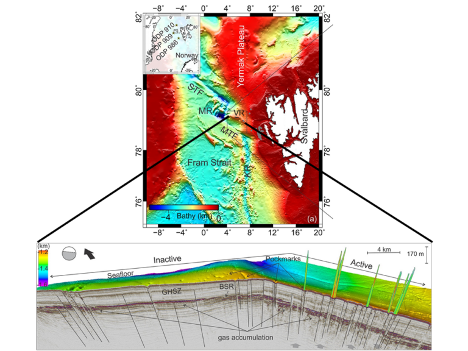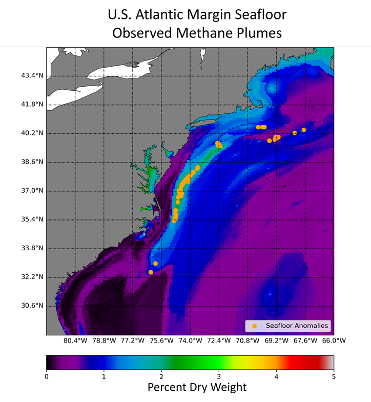In this project, we are using machine learning approaches to predict the properties of seafloor sediments on continental margins and how those properties propagate downward during burial and affect hydrate and gas distribution. We are interested in (1) how Arctic marine hydrates will respond to ocean warming, (2) how gas might contribute to submarine slope instability on the US Atlantic margin, and (3) shallow marine geohazards in the Gulf of Mexico.
Faculty Supervisor
Hugh Daigle
Researchers
Olin Carty (MS student)
Gabrielle Jacoby (Undergraduate)
Xu Tian (MS student)
Recent Highlights
- Predicted gas column height and gas pressure after ocean warming offshore Svalbard, Norway
- Demonstrated spatial relationship between machine learning-predicted seafloor total organic carbon and observed gas seeps on the US Atlantic Margin
- Predicted seafloor total organic carbon in the Gulf of Mexico
Major Projects
Seafloor gas emissions are widespread on Vestnesa Ridge. These gas emissions may be a result of elevated gas pressure, which fractures overlying sediments and allows venting through a fracture system (Figure 1). We are investigating whether gas released from dissociating hydrates over geologic time can produce a large enough gas pressure for this to occur.

Figure 1. Top: location of Vestnesa Ridge with relevant tectonic features. STF = Spitsbergen transform fault; MR = Molloy Ridge; MTF = Molloy transform fault; KR = Knipovich Ridge; VR = Vestnesa Ridge. Bottom: shallow seismic section with bathymetry showing location of active and inactive gas vents on Vestnesa Ridge. BSR = bottom-simulating reflection; GHSZ = gas hydrate stability zone. Figures modified from Plaza-Faverola et al. (2017).
The occurrence of gas in shallow marine sediments, especially associated with methane hydrates, is important for understanding carbon cycling and submarine geohazards. Recent observations of seafloor methane venting near the updip limit of the gas hydrate stability zone on the US mid-Atlantic margin suggest a relationship between hydrate dissociation and gas release, but this relationship has not been demonstrated in the subsurface. Scarce geophysical surveys make large-scale identification of gas difficult. We are using a machine learning-based approach to predict the presence of gas in sediments on the shelf and continental slope. Our results so far indicate that the observed gas seeps are strongly correlated with seafloor total organic carbon (Figure 2). This suggests a local source for these gas seeps rather than long-distance migration from other locations. Ongoing work involves modeling sediment properties at depth to predict where gas and hydrate are most likely to occur.

Figure 2. Predicted seafloor total organic carbon in % dry weight, with locations of observed gas seeps indicated by yellow circles. Seep locations from Skarke et al. (2014).
Shallow gas accumulations and shallow fluid flow are hazards for submarine infrastructure in the Gulf of Mexico. Predicting the occurrence of these hazards can be challenging. In this project, we are using geospatial machine learning to make predictions about where shallow gas is most likely to be found in the Gulf of Mexico. Our results will be combined with fluid flow modeling to make probabilistic estimates of the location and abundance of shallow gas accumulations. Figure 3 shows the predicted seafloor total organic carbon.

Figure 3. Predicted seafloor total organic carbon in the Gulf of Mexico. Colorbar is predicted value in % dry weight.
Subsurface Applications
Geohazards
Geophysics
Technical Disciplines
Formation evaluation
Drilling
Production
Engineering Tools
Machine learning
Numerical simulation
Contact
Hugh Daigle - This email address is being protected from spambots. You need JavaScript enabled to view it.
512-471-3775





